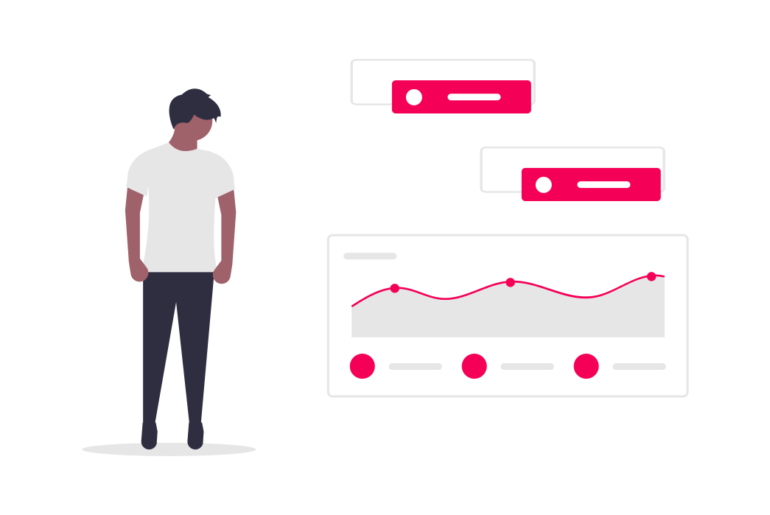Learn what is ad tracking, how it works, and how online businesses should track ad campaigns for optimum return of ad spend.
Have you ever questioned why you keep seeing advertising based on your searches?
You looked up or read an article about adding more exercise to your day, and suddenly, you started seeing advertisements for home gym equipment. This is a result of online advertising tracking.
Ad tracking is a big business today because of the abundance of data constantly being added to the internet.
With the help of relevant data, businesses can focus their attention more successfully on their advertisements.
To learn more about how consumers interact with their advertising campaigns and other online content, businesses and websites employ Google Analytics, one of the largest online advertising companies in the world.
In this post, we’ll deep dive into how ad tracking works:

What is Ad Tracking?
Ad tracking is the process of collecting data from ad campaigns. In addition, it can be used to monitor the return on advertising spend (ROAS).
With your digital advertising and customer data, you can collect many fine data points that make it simple to analyze how advertising campaigns affect sales in almost real time.
This begins by looking at the number of hits and views your website receives from search engines, which can be determined by the analytics offered by the best SEO companies.
It can also be observed in the length of time visitors stay on the website, which is now being increased thanks to the use of the services of top website design firms.
Before the internet, advertisers struggled to support their new ad campaigns with statistics since no data was available. In contrast, current digital advertisers have nearly too much data.
They have to spend a lot of time sorting through the massive amount of data they collect to find the most insightful patterns and trends.

Advertisers can more easily assess the efficacy of their advertising, test out new campaigns with no financial commitment, and swiftly make changes to their ads in response to the information they receive from their monitoring tools thanks to ad tracking.
Read More: A Complete Guide to Ad Conversion Tracking for Publishers
What Information do Ad Trackers Collect?
Ad trackers gather data such as an online user’s search history and previously visited websites. In addition, they can track a user’s interactions with advertisements, including clicks.
They also gather information about a user’s purchases, such as what they have in their virtual shopping carts and what they have purchased. Through ad tracking, there information can also be tracked:
- Location
- OS, Device, and Browser in use
- ISP (Internet Service Provider)
- Time/Day
- Language
- Type of Connection
In addition, ad trackers can benefit from the details people share on social media, such as their age, location, interests, religion, etc.
Online user’s IP address can also be accessed by trackers, providing advertisers with information about where they are located.
All these informations helps advertisers and marketers create customised ads for target users.
5 Types of Ad Tracking Methods
There are numerous ways to track ads. But, ultimately, it is up to you to choose the approaches that are most suited to achieve your objectives:
1. Tracking Pixels:
An email tracking pixel consists of a 1 x 1 pixel picture area placed within an email’s content. The tracking pixel sends this information to you when a recipient opens an email to see the message, informing you that the email has been opened.
You may learn important details about your customers’ purchasing processes and interactions with your business by using tracking pixels.
However, you must use them sensibly and limit the data you track to that pertinent to your connection with a consumer and intended to enhance their brand experiences.
Tracking pixels are a fantastic tool for streamlining the typical customer’s purchasing process with your business.
Read More: What is Ad Trafficking & Is it Relevant in 2023?
2. Cookies
Almost every internet user has some level of familiarity with cookies. Nearly all significant websites request users’ consent to set cookies when they visit these pages for the first time.
Cookies are temporary internet files that give marketing departments useful information about how users interact with their websites.
However, websites must obtain users’ explicit authorization before using cookies, which is why today, almost every major website loads with a cookie request.
Read More: How Publishers are Preparing for the Cookieless Solutions
3. DoubleClick Ad Tracking:
Google purchased the DoubleClick ad platform in 2008, which is currently used to manage ad campaigns for marketers across various platforms efficiently.
This most likely happened due to DoubleClick ad tracking if you recently looked at a product offered for sale on an online retail website and noticed advertisements for that item seemingly following you throughout the internet.
Google has rebranded the core components of its DoubleClick platform as Google Marketing, Google Adwords, and Google Ad Manager.
The method makes the most effective use of advertising space on a particular website by analyzing user behavior using first-party and third-party cookies.
Read more: DoubleClick for Publishers (DFP): FAQs
4. Facebook Ad Tracking:
Facebook is still the most prominent social media site, and for many companies, Facebook advertising is now a key digital marketing tool.

The Facebook ad tracking pixel can be used to develop specific target audiences for ads, learn how user interaction with your Facebook page affects visitors to your website, and assess purchase intent.
Read More: Facebook Monetization: Everything You Need to Know
5. URL Tracking
URL tracking is the most basic type of ad tracking. When a user clicks a link connected to your multi-channel ad campaign, you receive a report indicating which channel created the link.
This is a very helpful technique for monitoring the effectiveness of several advertising channels utilized in the same campaign.
These are just a few efficient ad-tracking strategies you may use immediately. But, naturally, the most effective monitoring for your company depends on how you promote your goods and services.
Tracking pixels makes it easier to gather information regarding open and click-through rates if you substantially rely on email marketing.
Read More: 7 Digital Ad Publishing Trends That Drive Monetisation
Advantages of Ad Tracking
Here are some tried-and-tested advantages of including ad tracking in your digital marketing plan:
1. You Gain Insights about Your Target Audience:
With ad tracking, you can track multiple metrics, including:
- Views
- Impressions
- Clicks
- Engagement behaviour
- Demographic information
- Buying habits
Ad tracking could give you the advantage over your competitors in this scenario.
If your ads aren’t relevant to your audience, your ad spend will be a waste. Knowing your target audience’s behaviour and preferences help create tailored ads.
2. Better Ad Campaigns Can be Created:
With ad tracking, you create advertisements that your audience will engage with.
Monitoring crucial advertising data like cost-per-click, conversion, and click-through rates become simpler the more ad tracking you employ. Each of these metrics directly influences your ad expenditure.
Remember that failing to track your advertisements can result in your company continuing to pay for clicks with low value and increased CPC.
Read More: 4 Proven Ways to Boost the Performance of your Ads
3. Your ROI Increases:
Digital marketing campaign spending is a complex task. However, every business owner wants to see good results in their advertising investments.
But how can you guarantee a favorable ROI if you need to know what ads to create?
The returns are significantly better because the conversions instantly soar.
After all, ad tracking enables you to make audience-specific advertising that you know they will adore.
4. Sync Marketing Initiatives Across Platforms:
A company can no longer solely concentrate on one platform. Multi-platform advertising is essential to stand out from the competition and cut through the noise.
However, coordinating a multi-platform strategy can take a lot of work. Ad tracking eliminates this concern because it makes it simple to track the reaction and market to the same audience across media.
For instance, using Facebook Pixel, you may create unique audiences for Facebook ad campaigns based on the type of traffic that your website receives. In addition, the ease of ad tracking can help your marketing initiatives.
How do Companies track you Online?
Have you ever questioned why you keep seeing advertising based on your searches?
You looked up or read an article about adding more exercise to your day, and suddenly, you started seeing advertisements for home gym equipment. This is a result of online advertising tracking.
Companies like Google, Facebook, and Amazon track your online activity in various ways to determine which advertisements to personalize for you. Advertising cookies are advertisers’ most fundamental and widely utilized internet tracking methods.
Cookies are tiny files your web browser saves and stores on your computer. Most websites use cookies to remember your computer and IP address for future visits.
For instance, when you want to connect to a website but don’t want to enter all your login information again, this might be really beneficial.
Cookies enable many of the modern web’s conveniences, such as storing things in your shopping cart and viewing localized weather predictions.
Advertising cookies, often those of an ad company, are also kept on your device, allowing businesses to learn more about your online behavior and present you with more relevant advertisements.
But it’s not just cookies; businesses may also track you based on your particular, distinctive device.
Device fingerprinting leverages a device’s unique characteristics, such as its operating system, the web browser it is currently using, its IP address, and other details, to distinguish it from the vast majority of other devices on the market.
Your activities can then be tracked using this information, and you can be the target of specialized, even custom, advertising campaigns.
Is Ad Tracking Illegal?
One main argument against ad tracking is that it invades privacy. This prompts us to consider whether ad tracking is legal.
Regrettably, there is still uncertainty around the legality. While there have been no laws governing ad tracking, the EU’s General Data Protection Regulation now provides some user protection.
GDPR mandates that websites get users’ agreement before collecting personal data, including details about your location or economic, social, or cultural identity.
Any website that offers visitors advertisements must obtain your explicit consent before using third-party cookies to comply with GDPR. However, most users must read the terms and conditions completely to opt-in.
Regulators need help determining whether the tracking has been done in accordance with the legal requirements, given the enormous volume of data processed by ad tracking software.
Users in the US are entitled to request the erasure of personal information collected by such ad tracking techniques, and corporations are required to notify customers of any potential data breaches under the California Consumer Privacy Act.
Ad tracking tools, however, are exempt from GDPR’s requirement to get users’ consent before tracking them. As a result, ad tracking systems can automatically track users and gather data without breaking the law unless they want to opt out.
Read More: CCPA VS GDPR: Overview, Differences, and Similarities
Common Ad Tracking Mistakes:
Despite the vast array of advantages that ad tracking provides, it is simple for marketers to make these frequent errors that prohibit them from making the most of the tool. Here are a few to be wary of:
1. Including your internal sessions:
Always be certain that your IP address is not included in the data you attempt to track, including internal sessions.
Otherwise, you will notice an exaggerated number of visitors when in fact, the visits that are logged are your own.
2. Forgetting to track conversions:
The main advantage of ad tracking is to assess vital statistics that offer important insights into your audience’s behavior on your site and their interactions with your advertising.
However, failing to track the conversion data can render the exercise pointless and potentially have an impact on your subsequent initiatives.
3. “Set it and forget it” mentality:
Ad monitoring results must be consistently analyzed if you want your efforts to produce long-lasting effects. To make the necessary changes to your ad tracking techniques, look at the essential KPIs.
It is advisable to avoid viewing ad monitoring as a one-and-done exercise because the data you obtain from it is valuable.
4. Not Filtering Ghost Spam:
Your marketing efforts may suffer if you view analytics data that has yet to be filtered to exclude fraudulent visit inputs. Despite having no interaction with your website, these phony visits offer you the impression that you are getting visitors.
Most marketers ultimately mistake such phony traffic for actual interest in the website and continue to serve consumers with adverts. Setting up necessary filters will guarantee that you only receive accurate data.
5. Missing Annotations:
The custom text you can enter for specific dates is called annotations. Annotations are beneficial since they simplify learning what transpired on a particular date.
If you don’t include annotation, you’ll constantly have to make assumptions about what happened that day if you detect an unexpected increase in traffic. On the other hand, such data can be very helpful when comparing advertising data from various periods.
Conclusion:
Your company may monitor its marketing initiatives and campaigns by using competitive ad tracking. Start by tracking users’ interactions with your brand using cookies, pixels, and URLs.
It is supported by search- and social-focused technologies that show your business where its advertising is effective, where they fall short, and where they need to improve in order to boost user engagement and sales.
FAQs on Ad Tracking:
Ad tracking occurs when businesses follow their customers online and use cookies and other tracking technologies to learn about their online behavior and preferences to provide targeted adverts.
The best way to gauge a campaign’s success is through ad tracking. Advertisers employ ad tracking techniques to run better, more targeted ad campaigns.

Shubham is a digital marketer with rich experience working in the advertisement technology industry. He has vast experience in the programmatic industry, driving business strategy and scaling functions including but not limited to growth and marketing, Operations, process optimization, and Sales.




![CTV vs OTT Advertising: Which one is Right Pick for Publishers? + [6 Bonus Strategies] Ott vs Ctv](png/featured-image-270x180.png)


